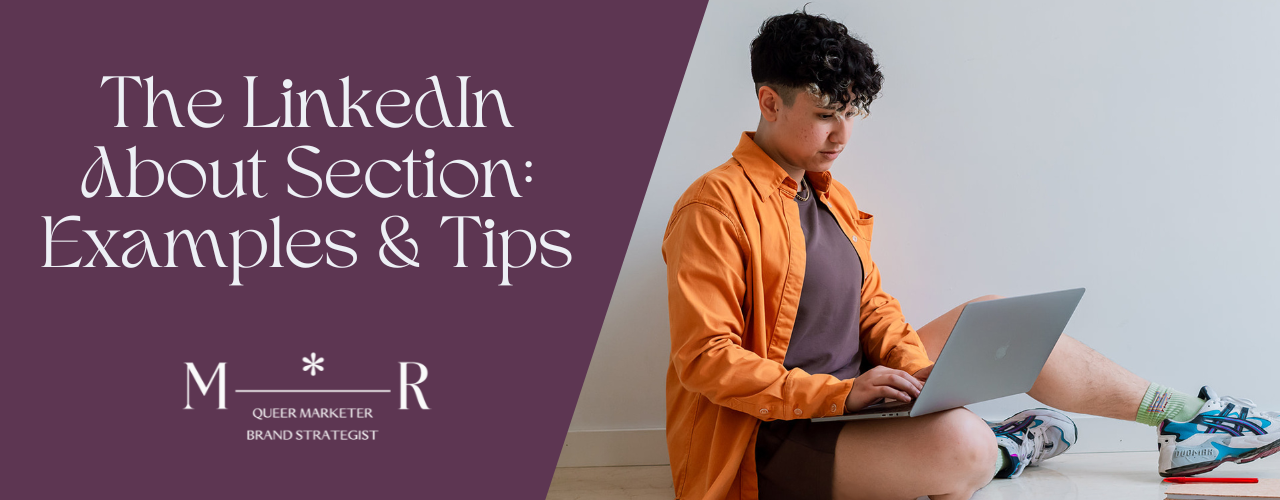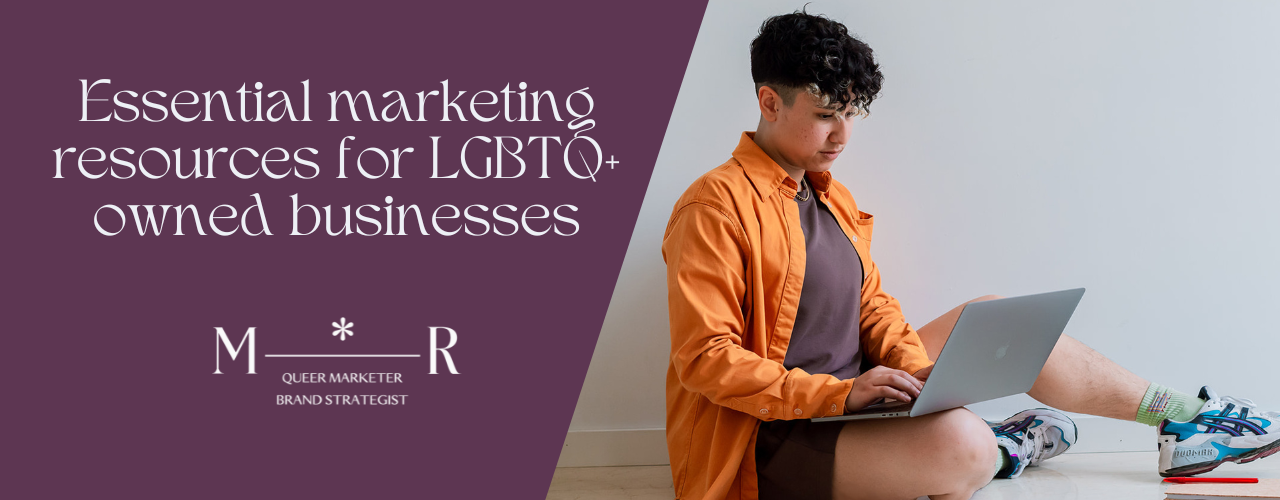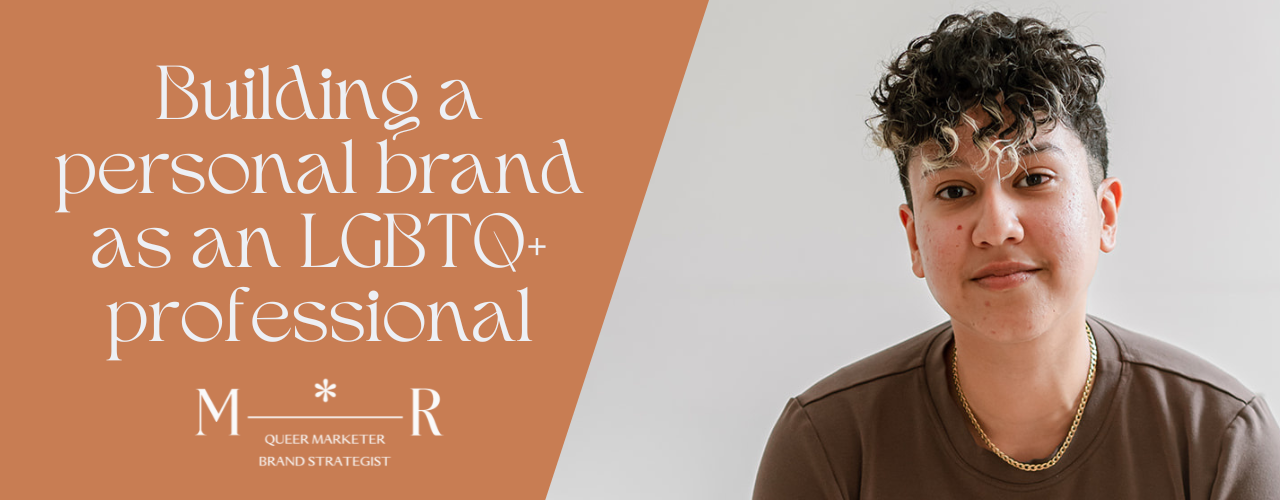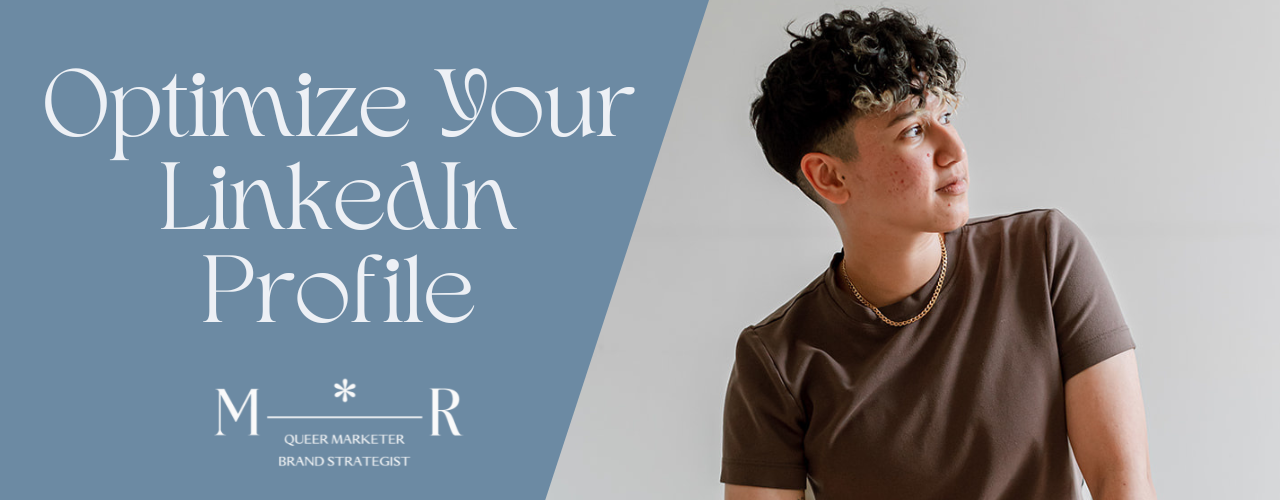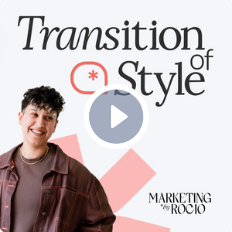Writing a solid LinkedIn about section, or summary section, is a creative process, one that has a lot more flexibility than a typical resume byline that succinctly puts together your career trajectory and goals. On LinkedIn, the rules are looser than the typical resume writing rules, so you don’t need to worry so much about writing it in a very particular way.
I’ve heard from different LinkedIn experts, from recruiters on LinkedIn Learning to LinkedIn consultants, polar opposite advice. A recruiter might say to keep your about section as short as possible, and a consultant might say to milk every character you have.
What do I – as a queer digital marketer of color – have to say about it?
I suggest a balance of the two: keep your strongest thesis statement within the first 150-220 characters before you get to the “see more” of the about section – then really try to highlight the most prominent stories of your career while weaving in keywords related to your industry and role.
This is a lot easier said than done, especially since every individual professional has different career goals and every industry is different.
Not to mention, cultural differences may also call for different storytelling techniques. My marketing storytelling approach is very influenced by Don Miller’s Building a Storybrand, as well as my upbringing in American society. There’s also influence from my time in France and the Netherlands.
On the other hand, you’ll find here a lot of digital marketing best practices for LinkedIn that are proven from years of experience and industry research.
Most importantly, some techniques simply won’t match with your own priorities of privacy and psychological safety (how out there do you really want to be, for example?)
So, read these techniques with a grain of salt: take what works, leave the rest.
The power of a call to action in your LinkedIn summary section
Once you hit about 150-220 characters, LinkedIn’s userface will automatically shorten your summary section and create a “see more” hyperlink.
This is where my digital marketing brain jumps in: no matter how long your summary section, you should make sure you answer the most important question your ideal audience is asking: why should we hire you?
And then – here’s the most important part – make sure to let them know what to do next.
Take these for example:
If you’re a job-seeker who wants to be in a project management role: “If you’re a recruiter looking for a dedicated project management professional to join your team, let’s chat. Reach out to me to explore how I can contribute to your organization’s success.”
If you’re a graphic designer who works for sustainable brands: “Sustainable brands need visual branding to match their values of a greener future – if you want this for your business, hit me up on [insert URL here].”
If you’re a DEI consultant who wants more consultation gigs: “Diversity, equity, and inclusion has proven to improve workplace morale and productivity. Not sure where to start? Let me walk you through it, all you have to do is DM me.
If you’re a high-level operations professional who wants to be a LinkedIn influencer: “Don’t take business operations for granted, follow my LinkedIn profile to learn about avoiding operations pitfalls.”
See where I’m going here? Lay down the stakes: what does your audience want? And how can you achieve it for them? Then, let them know how they can start working with you.
Optimizing the character limit of the LinkedIn about section
Now that you’ve already made your pitch and made it clear where people should go next, it’s time to support your argument in the rest of the summary section.
In the LinkedIn about section, you have about 2,600 characters to work with. That roughly translates to 500 words. Think of it as a short introductory essay – and I say to use it to the maximum capacity.
If you’re not much of a writer, you could go the way of lists. Highlight your proudest accomplishments in previous projects. This can be slightly different than what you highlight in your LinkedIn experience section, which can go further into detail of specific capabilities like software knowledge.
Include relevant keywords from your job search or competitive analysis
If you’re a job-seeker, chances are that you already spend a not-insignificant amount of time on job boards. These are a treasure trove of keywords that you definitely want to use in your about section.
Does the project management role require deep knowledge of software from Asana to Notion? Make sure to include this in your about section.
Do you want to work for social impact businesses and see DEI and ESG used all over job listings? Include those in your summary section, too!
Use these keywords in a way that make sense. Don’t just list them out with no link between them.
If you’re a business owner, freelancer, or personal brand – do competitive analysis. See what your competitors are saying on LinkedIn, and make a list of most-used words that you can also use in your profile.
Maximize white space to communicate your accomplishments on LinkedIn better
Whitespace, or negative space, is a must-have in digital content for some pretty good reasons. It helps your content become more readable and easier to understand, keeping things well-organized and reducing the brain strain for your audience.
Plus, it makes your summary section visually appealing to the human eye. When it comes to mobile, it ensures your content looks good on all screens. And if you use it smartly, it can even become a part of your brand’s signature style.
In a nutshell, whitespace is your buddy when it comes to creating a solid LinkedIn about section.
Use emojis to attract the eye
LinkedIn’s formatting capabilities has some work to do, but that doesn’t mean you can’t make formatting work in your favor. A simple way to break up text to make more white space, is to use emojis as bullet points.
Add testimonials
This one is optional. If you have previous testimonials or references from previous managers or clients, and want to makes sure you reach that 2,600-character limit – include these testimonials in your profile!
Don’t forget to add CTAs throughout your LinkedIn about section
Throughout your summary section, make sure to remind your reader to “reach out”, “DM”, “visit the website.” Calls to actions – or CTAs – are visual reminders for someone to act, and they’re quite effective at this!

Highlighting your queer and overlapping identities on your LinkedIn profile
If you’re a queer professional and/or professional of color with strong political leanings, you probably worry about this reflecting poorly on your profile. This is a strong reminder that your life is dignified just by you being here. LinkedIn is not the be-all end-all – it is a tool.
It is always up to you to disclose your identities outright. You could end up at a progressive company that values you for who you are, who knows? On the other hand, depending on the industry and your location – or quite simply, your desire for privacy – your concern for safety might lead you to the very valid decision to keep this information under wraps.
So throughout my LinkedIn for LGBT+ Professionals series, I want you to keep it all in mind: these are suggestions that are supported by lived experiences, work experiences, and industry best practices. But if it doesn’t work for you, don’t do it – plain and simple – I give you enthusiastic permission to make this choice, not that you need it!If you struggle with the rest of the profile, don’t worry. I have in-depth articles on finding your LinkedIn audience as well as making a solid header image to visually draw your profile visitor to the rest of your profile, all you have to do check out the blog.

